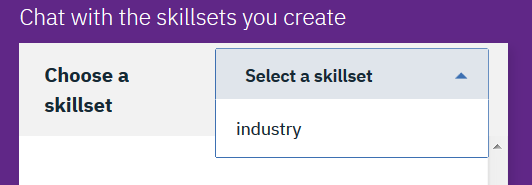Finding key parameters
When you connect your audio clients, Slack bots, and proactive agents to the assistant and when you converse with your assistant, you specify some parameters that identify your client, your tenant, your skills, and your skillsets. Use the following guidance to help find the required parameter values.
Watson Assistant Solutions host address
If your tenants are provisioned on the US South (Dallas) data center, use the following URL as the host address or to access the console:
https://watson-personal-assistant-toolkit.mybluemix.net
If your tenants are provisioned on the German (Frankfurt) data center, use the following URL:
https://watson-personal-assistant-toolkit.eu-de.mybluemix.net
Watson Assistant Solutions Audio Gateway URL
To connect your audio client to Watson Assistant Solutions, you must specify the address of the Audio Gateway component. Use the following URL:
wa-audio-gateway.mybluemix.net
If you are using the sample Java-based client, do not include the protocol prefix https://.
To connect your custom audio client to Watson Assistant Solutions using the web socket interface, use the following address:
wss://wa-audio-gateway.mybluemix.net
Tenant ID
Depending on how your account is provisioned, you might have access to more than one tenant. When you send a converse request to Watson Assistant Solutions, you must specify to which tenant you want the core routing component to send the request.
In the Java-based audio client or a custom audio client, you must specify a tenant ID if the IBM ID used for authentication has more than one tenant ID associated with.
To locate your tenant ID, click Admin > Usage on the console.
Skillset
Skills are grouped into skillsets. When you send a converse request to Watson Assistant Solutions, you must specify to which skill or skilset you want the core routing component to send the request.
To find the list of skillsets that are associated with a tenant, see the list that is available on the console home page.

User ID
The parameter userID is supported in a converse request from the client to the core routing component. It is a mandatory parameter when you coverse using the text or audio web socket interface.
The parameter represents the ID of the end user who made the utterance. For example, if three family members share a smart speaker, you might want to set userID to the ID of the user who is conversing with the smart speaker.
The parameter is not a server-side parameter.
Client ID
The parameter clientID is supported in a converse request from the client to the core routing component. It is an optional parameter when you converse using the text interface. It is not currently supported using the audio web socket
interface.
The parameter represents the ID of the client device. For example, the ID of the smart speaker.
The parameter is not a server-side parameter.
Device Type
The parameter deviceType is supported in a converse request from the client to the core routing component. It is an optional parameter when you converse using the text interface. Using the audio web socket interface, the deviceType value currently defaults to WSS-Rest and cannot be modified.
The parameter is not a server-side parameter.
IBM ID and IAM key and token
Watson Assistant Solutions using IBM Identity and Access Management (IAM) for authentication.
To access your tenant, you must have an IBM ID.
To access your tenant through Watson Assistant Solutions REST APIs, you must create an IAM API key for your IBM ID. Convert the IAM API key to an IAM token. The token expires after an hour.
If you are using a Watson Assistant Solutions application, such as the sample audio client, you specify an IAM API key, and the application takes care of creating the IAM token.
For instructions on creating IBM IDs, IAM keys, and IAM tokens, see the Accessing your tenant topic.
Use the following ways to access your services:
- Watson Assistant Solutions console: Specify an IBM ID.
- REST API calls: Specify an IAM token.
- Sample audio client: Specify an IAM API key.
- Custom audio client: Specify an IAM token.
- Slack bot: Specify an IAM API key.
Multiple IBM IDs can be associated with a tenant. For more information, see Managing your tenant.
